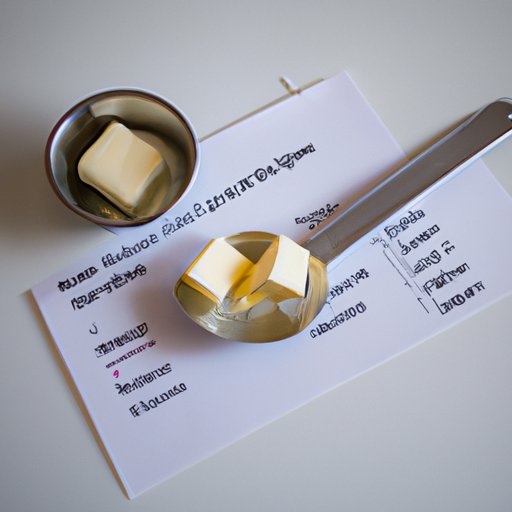Introduction
As avid bakers will attest, baking requires precise measurements to ensure the perfect texture, flavor, and appearance of your baked goods. One common problem that many people face when baking is determining how much butter to use in a recipe. Often, recipes will call for butter in terms of sticks, leaving many bakers to question how many teaspoons of butter are in a stick. This article aims to provide a complete guide on how to accurately measure butter for all your favorite recipes.
Baking Essentials: Understanding the Ratio of Butter and Teaspoons in a Stick
Before diving into measuring butter, it’s essential to understand the standard measurement of a stick of butter. A stick of butter typically equals 1/2 cup or 8 tablespoons. It is also packaged in quarter-pound sticks, which equals 1/2 cup or 1 stick of butter.
The ratio of butter to teaspoons varies depending on the amount of butter called for in a recipe. Generally, for every 1 tablespoon of butter, there are 3 teaspoons of butter. So, a stick of butter, equaling 8 tablespoons, would be 24 teaspoons of butter in total.
To calculate the appropriate amount of butter for a recipe, you will need to determine how many tablespoons or teaspoons the recipe calls for and adjust accordingly.
How to Accurately Measure Butter for Your Favorite Recipes
Using the appropriate amount of butter in your recipe is crucial for achieving the desired texture and flavor in your baked goods. To measure butter accurately, there are a few tips and tricks to keep in mind.
The most accurate way to measure butter is to use a kitchen scale. Simply weigh out the amount of butter needed in grams, ounces, or pounds, and adjust as necessary.
If you don’t have a kitchen scale, you can also measure butter using tablespoons. One tablespoon of butter equals 3 teaspoons of butter. However, it’s essential to note that using packed or leveled tablespoons can impact accuracy differently. Packed tablespoons can yield more butter than a leveled tablespoon, making your recipe richer than intended. Therefore, it’s always best to weigh your butter or use level tablespoons as a measurement if you don’t have access to a scale.
Another tip for measuring butter accurately is to take the time to soften your butter if needed. Softening butter allows for easy measurement, so be sure to leave your butter out at room temperature for a while before you start measuring it for your recipe.
Converting Butter Sticks to Teaspoons: A Quick Guide
Converting butter sticks to teaspoons can be a bit confusing, especially if a recipe calls for an odd number of tablespoons or teaspoons. Here is a quick conversion chart to help you accurately measure the butter you need.
| Number of Sticks | Teaspoons |
|---|---|
| 1/4 stick (1/8 cup or 2 tablespoons) | 6 teaspoons |
| 1/2 stick (1/4 cup or 4 tablespoons) | 12 teaspoons |
| 1 stick (1/2 cup or 8 tablespoons) | 24 teaspoons |
| 2 sticks (1 cup or 16 tablespoons) | 48 teaspoons |
| 3 sticks (1 1/2 cups or 24 tablespoons) | 72 teaspoons |
Here is an example of how to convert butter sticks to teaspoons using the conversion chart. Suppose a recipe calls for 1 1/2 sticks of butter. You would multiply the amount of sticks by the number of teaspoons in each stick. So, 1.5 sticks multiplied by 24 teaspoons per stick equals 36 teaspoons of butter needed for the recipe.
The Science of Baking: Why Accurate Butter Measurements Matter
Measuring ingredients accurately is vital to the science of baking. The ratio of ingredients in a recipe plays a crucial role in the texture, flavor, and appearance of a baked good. Too much butter can overpower the other ingredients and result in a heavy, greasy-tasting product. On the other hand, too little butter can result in a dry, crumbly baked good. Therefore, it’s crucial to measure butter accurately to ensure the perfect balance of flavors and textures in your baked goods.
Baker’s Secret: How Many Teaspoons of Butter in a Stick You Need to Know
Accurate butter measurements are key to perfecting your baked goods. We hope this complete guide has provided you with all the necessary information to measure butter accurately using sticks and teaspoons. Remember to use a kitchen scale whenever possible and take the time to soften your butter correctly. With these tips and tricks, you can bake with confidence and produce the perfect baked goods every time.
Conclusion
Baking is a precise art, and measuring ingredients accurately is essential to success. Measuring butter is one of the most important aspects of baking, and getting it right can make all the difference in your final product. Remember to use this guide as a reference whenever you’re unsure about how much butter to use in a recipe. With the right measurements, you can create delicious, beautiful baked goods that will impress everyone.
